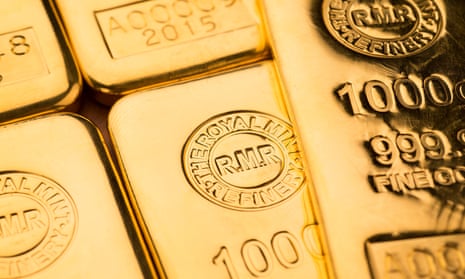Introduction: Pound hits 10-month high against US dollar
Good morning, and welcome to our rolling coverage of business, the financial markets and the world economy.
The pound has climbed to a 10-month high against the US dollar, as signs build that inflationary pressures in America are easing.
Sterling hit $1.2546 this morning, the highest since last June, as the dollar dropped on the foreign exchange markets on hopes that the US Federal Reserve could stop lifting interest rates soon.
The pound has staged quite a recovery since its nadir last September, when it fell to a record low against the dollar after the mini-budget fiasco. It picked up as Jeremy Hunt tore up much of his predecessor, Kwasi Kwarteng’s, plans for unfunded tax cuts last autumn.
Chancellor Hunt has sounded upbeat about the economy’s prospects despite the UK recording no growth in February, during his trip to Washington DC for the IMF’s Spring Meeting.
He told reporters:
“The IMF have undershot on the UK economy for quite a long time.
“It has undershot in every year bar one since 2016. It is one of many forecasters.”
Hunt also said the UK government was willing to accept short-term damage to the economy from public sector strikes, rather than give in to pay demands and risk a longer-term hit from persistently higher inflation.
The pound’s rally shows the City is shrugging off the International Monetary Fund’s prediction that the UK will be the worst-performing advanced economy this year.
Instead, investors are focused on data showing that America’s inflationary surge could be fading.
Yesterday, the US producer price index for final demand unexpectedly fell by 0.5% in March, showing a slowdown in the prices being passed onto consumers. And on Wednesday, US consumer price inflation slowed to a near two-year low of 5%.
Fawad Razaqzada, market analyst at City Index and FOREX.com, says:
The US dollar continued to weaken on Thursday, mostly against currencies where the central bank still remains hawkish, or the economic backdrop is improving.
The dollar has come under renewed pressure after more signs emerged that inflation has peaked. Traders are thus betting that the Fed will stop hiking interest rates, and soon it may even start loosening its policy again.
We will have more US data in the form of retail sales and consumer confidence on Friday.
European stock markets are set for a positive start this morning:
The agenda
7.45am BST: French inflation rate for March
9am BST: IEA’s monthly oil market report
1.30pm BST: US retail sales for March
2.15pm BST: US industrial production for February
3pm BST: University of Michigan’s index of US consumer sentiment for April
Key events
Figures yesterday showing a rise in US jobless claims last week has also weakened the dollar.
Initial unemployment claims rose by 11,000 to 239,000 in the week to April 8, the first rise in three weeks, suggesting the US economy is losing momentum.
Alexander Zumpfe, a precious metals dealer at Heraeus, said:
“These economic data have reinforced the market’s assessment that the cycle of interest rate hikes is nearing its end, which makes gold attractive to investors as it does not pay interest itself.”
Gold and silver prices are rising

Precious metals prices are also rising, on the back of the weaker US dollar.
Gold is inching towards its record high, while the silver price has hit a one-year high.
Gold is on track for its second weekly gain in a row, with the weaker US dollar nudging up its price.
Matt Simpson, a senior market analyst at City Index, says:
“The appetite to sell the U.S. dollar in the wake of soft inflation data, lower yields and calls for a lower terminal Fed rate have been a huge driver for gold.”
Deutsche Bank analyst Jim Reid explains that the possibility of America’s central bank ending its interest rate increases soon are pushing up both metals. He told clients this morning:
Elsewhere yesterday, another asset class that benefited from the prospect of a pause in the Fed’s rate hikes were precious metals.
For instance, gold prices (+1.26%) climbed to their highest level in over a year, closing at $2,040/oz, which leaves it just short of its all-time high in nominal terms, when it hit an intraday level of $2,075/oz back in August 2020.
Overnight it’s risen a further +0.13% to $2,043/oz.
In the meantime, silver (+1.28%) was also at its highest level in nearly a year, hitting $25.82/oz by the close, and overnight it’s risen a further +0.63% to $25.99/oz, which would leave it at a one-year closing high.
The euro is also trading at a one-year high against the dollar.
The single currency strengthened after US producer prices unexpectedly fell in March, boosting expectations that the Federal Reserve is near the end of its rate hiking cycle.
Introduction: Pound hits 10-month high against US dollar
Good morning, and welcome to our rolling coverage of business, the financial markets and the world economy.
The pound has climbed to a 10-month high against the US dollar, as signs build that inflationary pressures in America are easing.
Sterling hit $1.2546 this morning, the highest since last June, as the dollar dropped on the foreign exchange markets on hopes that the US Federal Reserve could stop lifting interest rates soon.
The pound has staged quite a recovery since its nadir last September, when it fell to a record low against the dollar after the mini-budget fiasco. It picked up as Jeremy Hunt tore up much of his predecessor, Kwasi Kwarteng’s, plans for unfunded tax cuts last autumn.
Chancellor Hunt has sounded upbeat about the economy’s prospects despite the UK recording no growth in February, during his trip to Washington DC for the IMF’s Spring Meeting.
He told reporters:
“The IMF have undershot on the UK economy for quite a long time.
“It has undershot in every year bar one since 2016. It is one of many forecasters.”
Hunt also said the UK government was willing to accept short-term damage to the economy from public sector strikes, rather than give in to pay demands and risk a longer-term hit from persistently higher inflation.
The pound’s rally shows the City is shrugging off the International Monetary Fund’s prediction that the UK will be the worst-performing advanced economy this year.
Instead, investors are focused on data showing that America’s inflationary surge could be fading.
Yesterday, the US producer price index for final demand unexpectedly fell by 0.5% in March, showing a slowdown in the prices being passed onto consumers. And on Wednesday, US consumer price inflation slowed to a near two-year low of 5%.
Fawad Razaqzada, market analyst at City Index and FOREX.com, says:
The US dollar continued to weaken on Thursday, mostly against currencies where the central bank still remains hawkish, or the economic backdrop is improving.
The dollar has come under renewed pressure after more signs emerged that inflation has peaked. Traders are thus betting that the Fed will stop hiking interest rates, and soon it may even start loosening its policy again.
We will have more US data in the form of retail sales and consumer confidence on Friday.
European stock markets are set for a positive start this morning:
The agenda
7.45am BST: French inflation rate for March
9am BST: IEA’s monthly oil market report
1.30pm BST: US retail sales for March
2.15pm BST: US industrial production for February
3pm BST: University of Michigan’s index of US consumer sentiment for April

 1 year ago
100
1 year ago
100










 English (US)
English (US)